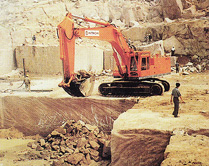 All mineral mining in China now has a set road to follow, and straying off its path will attract severe penalties.
All mineral mining in China now has a set road to follow, and straying off its path will attract severe penalties.
The country's first-round programs for provincial mineral resource exploitation took effect yesterday, setting output goals and designating mining regions.
"All the output goals are based on the national resource strategy and will help ensure sustainable development," said Pan Wencan, director of the Planning Department under the Ministry of Land and Resources.
For example, Northwest China's Xinjiang Uygur Autonomous Region and Shaanxi Province will step up their exploitation and use of petroleum oil, natural gas and coal as part of the changes.
And if a province's mineral output has surpassed the goal set in its program, it will be forced to reduce its output.
Pan believes the programs mark an essential shift from traditional extensive management to modern management in the country's mineral resource exploitation.
"For a country like China, which is in the preliminary stage of establishing a market system in the mineral industry, it is essential to avoid duplication and to save important mineral resources for sustainable development," said Pan.
"Detailed and scientific programs help greatly in this regard."
Therefore, the programs designate specific regions, encouraging, restricting or forbidding mining in these areas.
The two basic rules in designating different regions are to consider the resources of each based on data obtained in previous national geological surveys, and to take into account the special conditions of the area.
In particular, prospecting should be stepped up in areas near old mining regions, but deliberately limited in such areas as nature reserves.
For each designated mining region, the programs also set a "reasonable" mining capacity, production scale and technical level for firms applying to mine in the area.
"If there are already too many mining enterprises operating in the region, the comparatively smaller and more backward ones should be closed down," said Pan.
The programs have also fully considered the advantages and weak points of local economies. "Boosting the local economy" is one of the priorities which protect State interests.
Therefore, while Central China's Henan Province plans to use its geological advantage to build a national trade center for mineral products, East China's Jiangsu Province will develop its crystal, china and coal centers respectively in Donghai County, Yixing and Xuzhou cities.
Meanwhile, the ministry issued a circular to call for the programs to be implemented.
(China Daily January 16, 2003)
|

